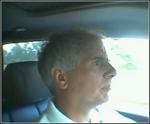HOWR Claims House
What had been a perfect chickadee nest was no more. I first noticed the HOWR's arrival at about 9:00 AM this morning. He was tossing out parts of the nest material. It took me a couple of minutes to get down to the house and I began my inspection.
Nest Material on Ground
After seeing the nest material, I checked the nest with my finger. No eggs and nothing sticky. The eggs should have been about 7 to 10 days old but there were none there. I looked around on the ground and found nothing. At first, I was puzzled. Then I looked harder on the ground.
Chickadee Egg On Ground
Another Chickadee Egg
After I knew the chickadee nest had been destroyed, there was nothing left to do but admire the nest-building effort. The moss area was several inches deep, deeper than the one in 2008. There was a fine fluff around the egg area that was incredibly soft to the touch. A lot of effort went into this nest.
Chickadee Nest
So, what went wrong? Well, nothing actually. I could have put a HOWR guard up. However, this HOWR flew to the hole from the ground in addition to flying to the hole from the roof of the house. They know where the hole is. I had been hoping for a vigilant male like the one that defended the nest in 2008. This one did down a downy woodpecker earlier. However, he was often missing from the nearby trees. This morning, the female also left the nest without the male nearby. This was all the HOWR needed. It broke and tossed the eggs out of the nest and was in the process of dismantling it when I stopped it.
Am I angry with the HOWR? No, it was just being a HOWR and a HOWR, like a chickadee, are native birds here. I am disappointed with the chickadees' lackadaisical defense of their nest since a chickadee is a match for a HOWR.
For my own part, I took down all my bird houses.


















































